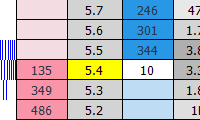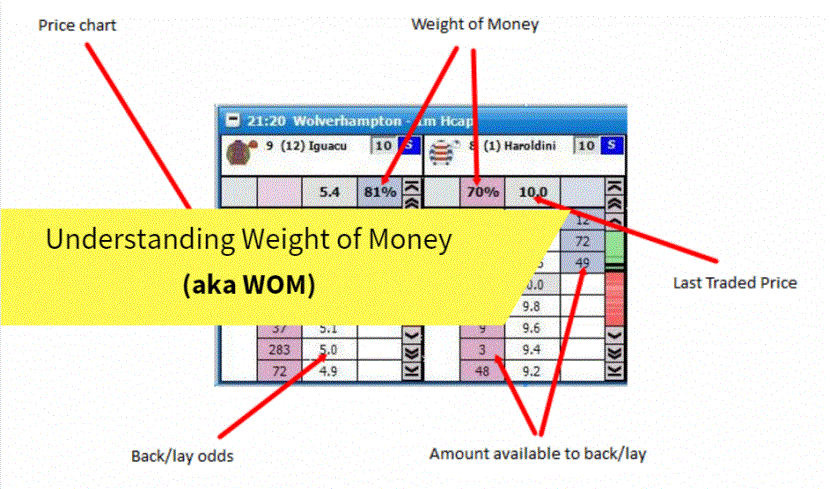Understanding weight of money, what it is, and how it may influence the market it is important.
Various aspects of weight of money (WOM) and the impact is has on a price have changed over time. However, knowing how it shapes a betting market is important to traders. It may well influence your opinion at crucial moments…
Let’s have a look at the following;
- Understanding weight of money on Betfair
- How WOM affects your trades
- Avoiding weight of money problems (fake WOM)
- Weight of money calculations and formulas
What is Weight of Money? (WOM)
Weight of money is a term used to define the amount of money within a market, influencing the movement of a price. Usually indicated as a percentage within various trading software’s. The WOM indicator itself is just a quick way of showing the balance of back and lay bets either side of the spread.
In theory, weight of money indicates the market sentiment. Or at least it used to…

In the Geeks Toy trading software, WOM looks like the above image.
The percentages expressed in the top of the ladder within the Geeks Toy show us the percentage of money, spread over the three prices closest to the available match. Obviously this is unmatched money, not to be confused with traded volume.
Weight of money calculation for the software looks like this:
If there was a total of £350 on the lay side of the book, and just £150 on the back side of the book (over the next available 3 prices). Then the weight of money calculation would be 70% to 30% in favour of the lay side of the book. Much like the right hand side of the image above.
The downside to this is; very quickly traders realised the weight of money figures could be manipulated.
I’m led to believe, in the early days of Betfair this could be considered as an indicator. Now it’s more likely to be traded volume, or weight of flow as it’s sometimes referred to.
Traded Volume is different to WOM. When traders refer to the traded volume they are talking about the money that has already been matched at a price.
See the example below:

If you look to the grey column fourth from the left, this is the traded volume column.
So as an example you can see, 1.3k has been traded at a price of 6.4 (second column from right).
Will Understanding Weight of Money Change Your Trades?
Possibly, depending on trading style and strategy.
When Betfair visited me in 2014 I still used to keep track of the unmatched money. In some cases it’s still relevant, although a lot rarer now. Various figures slosh up and down in the market, giving a false sense of security.
However, on occasion, it’s still possible to spot large amounts of unmatched money that wants to be genuinely bet. I’ve no doubt that WOM actually triggers various automation running on the exchange in some cases. But largely, it appears, various automation tries to conceal the genuine unmatched money.
Understanding weight of money that’s previously been matched is far more beneficial to forming a solid opinion. It’s harder to write-off as ‘fake’ right?
Monitoring traded volume is one thing, but monitoring which way the money’s ‘intent’ is headed is sufficiently harder. Especially when you consider the effect cross-matching has on the markets.
Spotting Fake Weight… (WOM)
So if we can’t use the WOM to our advantage in order to profit, can we use it to avoid unnecessary losses?
Yes.
Longer readers will know I bang on about avoiding losses as much as trading a profit. In this instance weight of money can be a telling indicator when it comes to ‘funny business’ in the market.
Ever noticed that money that;
- Flashes close to the available price?
- Gets dragged down but never actually wants to be matched?
- Sits around at prices like 10.5?
We’ve all been there right? Just before it disappears and you have a minor heart-failure. Watching the price rattle away into the red…
Don’t let it get you.
Some of the cheap tricks employed by automation centres around weight of money. Obviously it’s not always the case when you see a big bet, but bear it in mind.
On the other hand, if you’re feeling confident that you’re witnessing a bit of ‘funny business’ it might just be a good idea to take the fakery on. Do it at your own peril obviously, but in some instances it can prove quite profitable!
For that reason alone, I wouldn’t advise trying to twist the weight of money yourself… there’s often someone bigger watching.
Calculating Weight of Money…
Weight of money calculations aren’t particularly important to us as manual traders, but for clarity, the formula looks like this:
Monetary value of next three lay prices / (Monetary value of next three back prices + Monetary value of next three lay prices)

So, if that wasn’t clear enough;
Available Lay money = £970 because (135 + 349 + 486)
Available Back money = £891 because (344 + 301 + 246)
970 / (891 + 970) = 0.52
So in this instance the book is quite evenly balanced with the weight of money coming in at 52%. Hopefully that summarises weight of money for those that were interested…
Two Directly Related Articles: How Betting Odds Work? | How Cross Matching Works…


10 thoughts on “Understanding Weight of Money on Betfair (aka WOM).”
Brilliant stuff
Thanks Ali. Sometimes the things I’ve took for granted need clearing up 🙂 Glad it was helpful.
Good article. Concise as always. I for one appreciate all the work you put in, and with the youtube vids too.
If only a software vendor could create an indicator that perhaps uses an average true range calculation versus actual traded amounts at each price point to deliver a more realistic indication of true money flow and volume
Ah that fake money, it appears and disappears quickly also looks out of place when watching a market, I have seen it and was wondering where from? and why? I am guessing its there to try manipulate the market and scare a few traders…… Yes it can certainly do the latter!
is there a setting to change wom to say first 6
Not that I’m aware of Jack, sorry.
Another excellent post Caan and very clearly explained. Thank you
Cheers, Wayne. You prefer this kind of post then? A bit more explanatory…
Great post, never knew (wom) was only the next 3 prices.
thanks
Great video. So WOM can be skewed by cross matching? The back side is 4.1 and lay 4.0. Therefore, I’m assuming (as a person in learning and not staking stage of the trading journey) that the 33% means there is less back money coming into the market than lay money? Thank you.